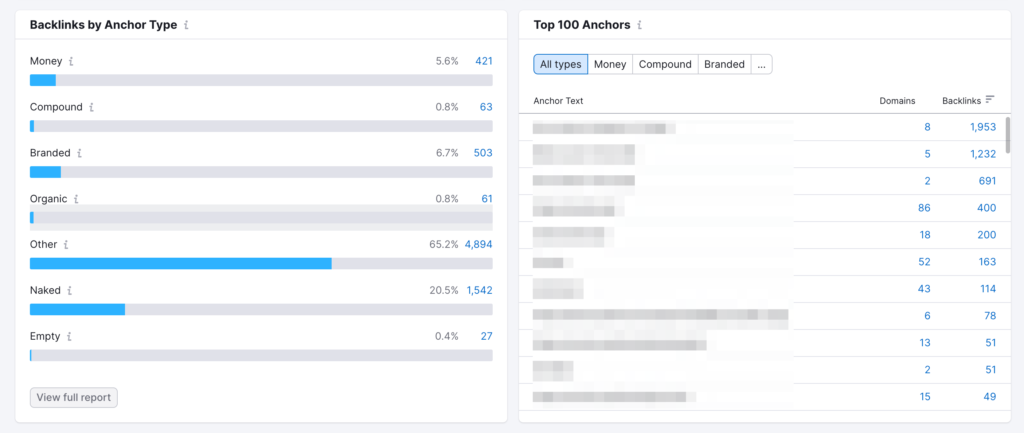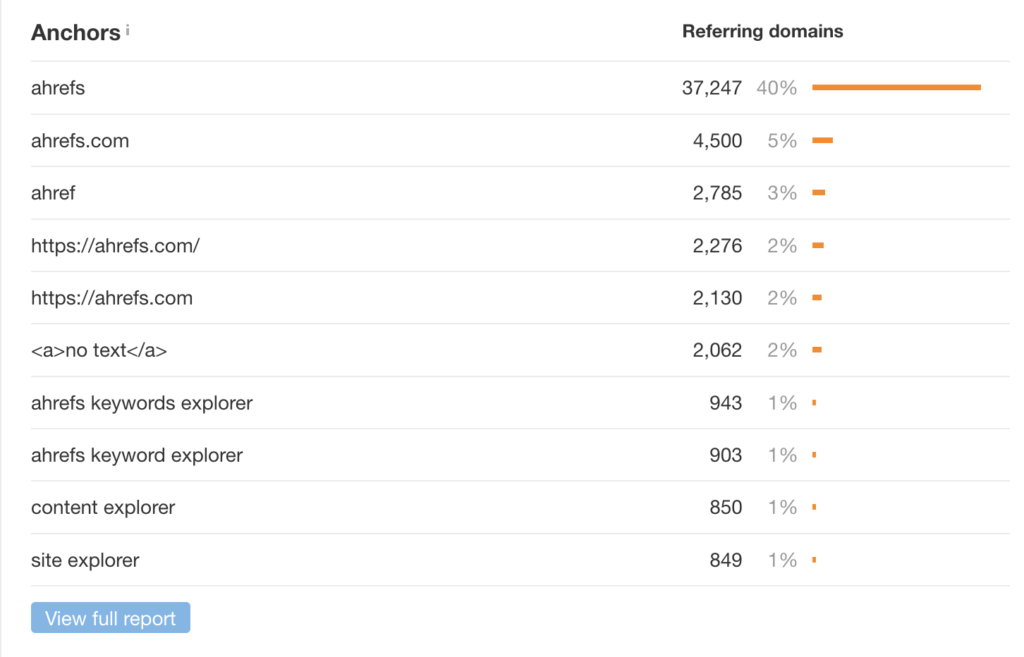
We have already written in our other article about how important are backlinks. Essentially, backlinks are a crucial factor in search engine optimization (SEO), and they play a significant role in improving your website’s ranking on search engine results pages (SERPs). The quality and relevance of the anchor text used in backlinks are important indicators of the authority and trustworthiness of a website. As such, anchor text analysis is an essential part of any SEO strategy.
In this ultimate guide, we’ll explore the various aspects of backlink anchor text analysis and provide you with a comprehensive strategy for building high-quality backlinks. We’ll cover everything from the basics of anchor text and how it affects your website’s SEO, to advanced techniques for analyzing your backlink profile and developing a link-building strategy.
This article will be helpful for both beginners and experienced SEOs alike and will provide you with the knowledge and tools you need to optimize your link anchor text and take your site’s SEO to the next level. So let’s get started!
What is an anchor text?
An anchor text is a clickable text that is used to hyperlink to another webpage or document. It is usually underlined and appears in a different color from the surrounding text, making it easily identifiable as a hyperlink. Anchor texts are important for both users and search engines as they provide contextual information about the linked page.
For users, anchor link texts provide a brief description of the content on the linked page, giving them an idea of what they can expect to find if they click on the link. For example, if the anchor text says “best SEO tools”, users can assume that the linked page provides information on the best tools for SEO.
For search engines, anchor texts help them understand the relevance and authority of the linked page. If the anchor text includes relevant keywords or phrases, it indicates to the search engine that the linked page is relevant to that topic. However, if the anchor text is vague or contains generic terms like “click here”, it provides little value to the search engine and may even be seen as spammy.
In summary, anchor text plays an important role in both user experience and search engine optimization. By using descriptive and relevant anchor texts, website owners can help users and search engines better understand the content of their pages, which can ultimately lead to higher rankings on search engine results in pages.
Why is anchor text important for SEO?
Anchor text is an essential element of search engine optimization (SEO) as it provides necessary signals to search engines about the content of the linked page. When a webpage links to another page using a specific anchor text, it indicates to search engines that the linked page is relevant to the topic or keyword used in the anchor text.
Anchor text helps search engines understand the content of the linked page and its relevance to a specific topic or keyword. If multiple web pages link to the same page with the same or similar anchor text, it signals to the search engine that the linked page is an authority on that topic. This can result in higher rankings on search engine results pages (SERPs) for that particular keyword or topic.
However, it’s important to note that anchor text can also have a negative impact on SEO if it’s overused or used in a spammy way. Search engines can penalize websites that use manipulative tactics, such as keyword stuffing, to game the system. Therefore, it’s essential to use SEO anchor text in a natural and relevant way that provides value to users and search engines alike.
In other words, anchor text is an important ranking factor in SEO as it helps search engines understand the relevance and authority of a webpage. By using descriptive and relevant anchor text in a natural way, website owners can improve their chances of ranking higher on search engine results on pages for specific keywords and topics. Especially if they turn to experienced professionals from the link building SEO company for this.

Types of anchor text
There are several types of anchor text in SEO that are commonly used in backlinking. Understanding the different types of anchor text is important as it can help website owners create a diverse and natural backlink profile. Here are some of the most common types of anchor text:
Exact match anchor text
This type of anchor text includes the exact keyword or phrase that the linked page is trying to rank for. While it can be helpful for SEO, it can also be seen as manipulative if used excessively.
Partial match anchor text
This type of anchor text includes a variation of the keyword or phrase the linked page is targeting. For example, if the target keyword is “best SEO tools”, a partial match anchor text could be “top SEO tools” or “SEO software”.
Branded anchor text
This type of anchor text uses the brand name of the linked website as the anchor text. It’s a great way to build brand awareness and credibility.
Naked anchor text
This type of anchor text uses a URL or a brand name without any other text as the anchor. For example, “www.example.com” or “Example.com” could be used as naked anchor text.
Generic anchor text
This type of anchor text uses generic terms such as “click here” or “read more” as the anchor text. While it may not provide much value for SEO, it can be useful for users as it provides context for different types of links.
Related keyword anchor text
This type of anchor text uses keywords that are related to the topic of the linked page as the anchor text. For example, if the linked page is about “best SEO tools”, related keyword anchor text could include “SEO software reviews” or “SEO tool comparison”.
Image anchor
This type of anchor text uses an image as the hyperlink, with the Alt text of the image serving as the anchor text. Optimizing the Alt text for keywords and relevance is important to improve SEO.
By understanding the different types of anchor text and using them appropriately in a natural and relevant way, website owners can improve the quality and diversity of their backlink profile, ultimately leading to higher rankings on search engine results in pages.
Anchor texts issues in backlink audit
When conducting a backlink profile audit, it’s important to pay close attention to the anchor texts used in the links pointing to your website. This is because anchor texts can have a significant impact on your website’s search engine rankings and overall online visibility.
An issue to be aware of is the use of potentially dangerous anchor text variations such as exact match, money anchors, and irrelevant (off-topic) and compound anchors. To address these anchor text issues, it’s important to conduct a thorough backlink audit and identify any potentially harmful links. From there, you can take steps to remove or disavow these links and work to build a natural and balanced backlink profile with a variety of anchor text types.
Overall, paying attention to anchor text issues in your backlink audit is crucial for maintaining a healthy and effective backlink profile that helps to improve your website’s search engine rankings and drive more organic traffic.
Anchor text analysis tips & tricks you need to know
Analyzing the anchor texts used in the links pointing to your website is a critical part of any successful and effective SEO strategy. Here are some tips and tricks you should keep in mind when analyzing your website’s backlink profile:
- 1. Use a backlink analysis tool: There are several tools available that can help you analyze your backlink profile and anchor text usage. One such tool is Google Search Console, a useful tool for monitoring your website’s backlink profile and identifying any potential issues. Another tool is Serpstat.com, which provides a comprehensive backlink analysis and can help identify errors in your anchor text profile. Popular solutions also include Ahrefs, Majestic, Moz, and SEMrush.
- 2. Check for over-optimized anchor texts: Over-optimized anchor texts, such as an exact match or money anchors, can be a red flag to search engines and may harm your website’s search engine rankings. Look for these types of anchor texts in your backlink profile and take steps to remove or disavow any potentially harmful links.
- 3. Diversify your anchor text: Maintaining a balanced and natural anchor text profile is important for avoiding penalties from search engines. Aim for a variety of anchor text types and avoid overusing any one type of anchor text.
- 4. Check for relevance: The anchor texts used in the links pointing to your website should be relevant to the content of your website or the page they’re linking to. Check for irrelevant or off-topic anchor texts and take steps to remove or disavow any potentially harmful links.
- 5. Monitor your backlink profile regularly: Your backlink profile can change over time, so it’s important to monitor your backlinks regularly and make adjustments as needed. Set up regular backlink audits and use the insights you gain to improve your anchor text optimization strategy.
By following these anchor text analysis tips and tricks, you can optimize your backlink profile and improve your website’s search engine rankings, ultimately driving more organic traffic to your site.

What are “potentially dangerous anchor texts?”
While anchor text can be a powerful tool for SEO, it’s important to be aware of potentially dangerous anchor text variations. These can be harmful to your website’s search engine rankings and can even result in penalties from search engines. Here are some common potentially dangerous anchor text variations to be aware of:
- • Money anchors: These are anchor texts that include keywords related to buying or selling products or services, such as “discounted car insurance” or “buy cheap shoes online”. Using too many money anchors can be seen as manipulative and can lead to penalties from search engines.
- • Compound anchors: These are anchor texts that include multiple keywords or phrases, separated by commas or other punctuation. For example, “best SEO tools, search engine optimization software, SEO tool reviews”. Using too many compound anchors can be seen as over-optimization and can harm your website’s rankings.
- • Branded anchors: While branded anchors are generally safe, using too many of them can be seen as manipulative and can harm your website’s rankings. It’s important to balance branded anchors with other types of anchor text.
- • Organic anchors: These are anchor texts that are too generic or vague, such as “click here” or “read more”. While they may not be harmful in small quantities, using too many organic anchors can harm your website’s rankings.
- • Naked anchors: These are anchor texts that use the website’s URL or brand name without any additional text. While naked anchors can be useful in some cases, using them excessively can harm your website’s rankings.
- • Empty anchors: These are anchor texts that don’t include any text at all, and only use the hyperlink itself as the anchor. Using empty anchors can be seen as manipulative and can harm your website’s rankings.
- • Other anchors: This category includes any other anchor text variations that may be potentially dangerous, such as using too many exact match anchors or using irrelevant anchor text.
As we can see, any type of anchor can be potentially dangerous if used incorrectly, but it’s important not to go too far with any of the types. To prevent the presence of such dangerous anchor texts, you should pay special attention to SEO guest posting. This is a common tactic for getting backlinks and improving your site’s SEO, and optimizing the anchor texts used in these guest posts can be an effective way to improve their impact.
Top 5 rules to create an anchor text optimization strategy
To create an effective anchor text optimization strategy, there are several key rules to keep in mind. By following these guidelines, you can improve your website’s search engine rankings and avoid penalties from search engines. Here are the top 5 rules for creating an SEO anchor text strategy:
Make it Natural
The most important rule of anchor text optimization in SEO is to make it natural. This means using a diverse range of anchor text variations, avoiding over-optimization, and focusing on high-quality backlinks from reputable websites.
Variety is Key
Using a variety of anchor text types is crucial for a successful strategy. This includes using exact match, partial match, branded, naked, and generic anchors, as well as related keyword anchors and image anchors. By using a diverse range of anchor text types, you can create a natural and effective backlink profile.
Pattern Recognition
It’s important to avoid any patterns or repetition in your anchor text. This means avoiding using the same anchor text too frequently, as well as avoiding any specific keyword phrases that may be seen as manipulative or over-optimized.
Content Relevance
Your anchor text should always be relevant to the content it links to. This means choosing anchor text that accurately describes the content on the target page, and avoiding any misleading or irrelevant anchor text.
Consider Page Types
Different page types may require different types of anchor text. For example, product pages may benefit from more commercial and branded anchor text, while informational pages may benefit from more generic and related keyword anchors. By considering the page type, you can choose the most effective anchor text for each page.
By following these rules for anchor text optimization, you can create a natural and effective backlink profile that improves your website’s search engine rankings and drives more organic traffic. For a deeper dive into the topic, you can refer to the Google developer documentation style guide, a resource that can be used to ensure your anchor texts are written in a clear, consistent, and effective manner.

Actionable Anchor Text Ratios
One key aspect of an effective anchor text backlink strategy is maintaining a balanced and natural distribution of anchor text types. While there is no one-size-fits-all ratio for anchor text types, there are some actionable anchor text ratios that can help guide your strategy.
- 1. Exact Match Anchor Text Ratio. This refers to the percentage of anchor text that is an exact match for the target keyword. While exact match anchor text can be effective in some cases, it should be used sparingly to avoid over-optimization. A good rule of thumb is to keep the exact match anchor text ratio below 10%.
- 2. Brand Anchor Text Ratio. This refers to the percentage of anchor text that includes your brand name or a variation of it. Brand anchor text is generally considered to be safe and natural, and can help establish your brand identity and reputation. A good goal is to maintain a brand anchor text ratio of around 50%.
- 3. Generic Anchor Text Ratio. This refers to the percentage of anchor text that is generic, such as “click here” or “read more”. While generic anchor text doesn’t provide much context for search engines, it can still be valuable for users and can help create a natural backlink profile. A good goal is to maintain a generic anchor text ratio of around 20%.
In general, these figures are very approximate, and there is no universal ratio for all sites. In order to sort out what ratio should be followed, it also makes sense to analyze the link profiles of competitors and see their typical ratio of anchors.
Finally, it’s important to maintain a variety of other anchor text types, such as partial match, related keyword, and naked anchors, depending on the content and context of the target page. By maintaining a balanced and natural distribution of anchor text types, you can create an effective and sustainable anchor text optimization strategy that improves your website’s search engine rankings and drives more organic traffic.
Wrapping up
In conclusion, anchor text optimization is a critical aspect of any successful SEO strategy. By understanding the different types of anchor text, avoiding potentially dangerous variations, and following best practices for creating a balanced and natural backlink profile, you can improve your website’s search engine rankings and drive more organic traffic.
At Mellow Promo, we offer a range of link-building services that can help you improve your website’s backlink profile and optimize your anchor text strategy. Our team of experienced SEO professionals can help you identify high-quality link-building opportunities, create compelling content that attracts backlinks, and develop a sustainable link-building strategy that drives long-term results.
Whether you’re a small business owner or a large enterprise, our link-building services can help you achieve your SEO goals and grow your online presence. Contact us today to learn more about our services and how we can help you improve your anchor text optimization strategy.





